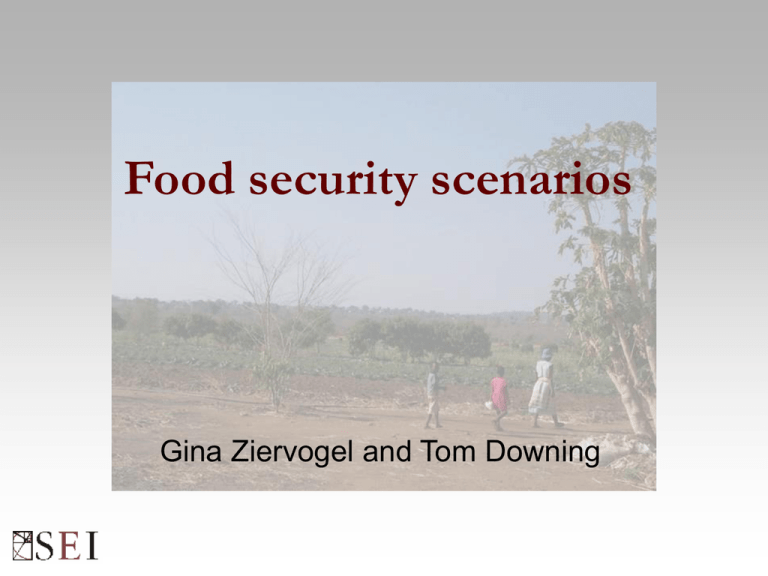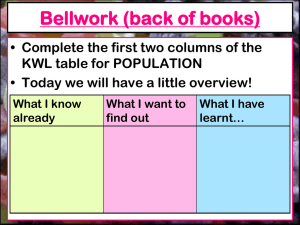Food security scenarios
advertisement

Food security scenarios Gina Ziervogel and Tom Downing • Why scenarios? • A pilot example – Global Scenario Group South African food security – Provincial level downscaling • Toward a research agenda – Livelihood based scenarios – Characteristic syndromes in global storylines Why scenarios? • Jeremiah – Warnings of impending doom – Visualisation of desirable futures Scenarios: Why and what? Why: The limits of prediction – Complex socio-environmental processes – Surprise and the kinks of history What: • Vision of a future time – Sufficiently beyond the present to not be inherently predictable • Internally consistent – Plausible relationships between elements, multiple attributes • Semi-quantitative – Associated with indicators or supported by formal models • Appropriate – Target time period, place, people – Relevant policy issue Methodologies • • • • • Visions and back-casting Model simulation and probability Worst case Stakeholder-led/interactive Role playing, gaming Examples • • • • Climate change (IPCC) Venetian visions (Ulysses) IFPRI coupled model Agent-based water demand (FIRMA) Climate change • Projections of global climate change • Based on: – Socio-economic scenarios of the future – Greenhouse gas emissions interpreted from the global scenarios – Global GHG emissions atmospheric concentrations – Global climate models IPCC: Global mean surface temperature GHG Scenarios: Special Report on Emissions Scenarios • Designed to bracket greenhouse gas emissions, and hence climate change scenarios • Government-scientist task force • Did not include sensitivity to climate impacts • Spawned UK Foresight scenarios, and others • Poor foundation for climate vulnerability – The poorest region when climate change occurs is as rich as the OECD is now SCENARIOS FOR VENICE, 2050 CURRENT DRIVING FORCES VISIONS Scenarios Narratives DEMOGRAPHIC ECONOMIC IDENTIFICATION BREAKING POINTS TRANSPORTATION GOVERNANCE CULTURAL Angela Pereira: JRC VISIONS OF VENICE, 2050 Tonight I’ll tell you about 4 cities Veniexia, Venusia, Venetia, Vinegia Marco Polo tells Kublai Kan… Visions of Venice 2050 Tourism has trickled to a small fraction Living conditions have deteriorated… Air and water pollution significantly affect human and ecosystem health Traditional activities close down Building Decay Emigration increases Gotham City A ‘new Venice’ in the mainland is created to preserve the cultural heritage Visions of Venice 2050 Venice became a cultural park and a museum city: one of the 4 most important tourist destinations of the world Corporations dominate economy and city life Carnival takes place 4 times a year Venezia Inc. Floods and high tides become tourist attractions Venice is a stage where the whole population acts in a gigantic performance IFPRI Coupled Water-Food System Model • Business as usual – Trend projection • Alternatives – Water scarcity – Sustainable water • Key indicators – Water use – Food prices Interactive, behavioural scenarios Aggregate demand series scaled so 1973=100 200 180 160 Agent based: 120 Discontinuities Large range of results 100 80 60 40 20 0 J- J- J- J- J- J- J- J- J- J- J- J- J- J- J- J- J- J- J- J- J- J- J- J- J73 74 75 76 77 78 79 80 81 82 83 84 85 86 87 88 89 90 91 92 93 94 95 96 97 Climate change impacts Simulation Date 250 BetaMH 100 GammaMH DeltaMH 50 2041 2039 2037 2035 2033 2031 2029 2027 2025 2023 2021 0 2019 Smooth scenarios Modest range AlphaMH 150 2017 Dynamic simulation: 200 2015 Relative Demand 140 South African food security • GSG: key indicators for food security • RSA: anomalies to Africa? • Mapping GSG to RSA Food security indicators • Results – Great transitions – Market forces • Observations South Africa is similar to Africa in the Global Scenarios Group Income and equity are major drivers Agricultural changes are modest, greater water stress in South Africa GSG Indicator South Africa Pop growth rate = Urban fraction = Income per capita +++ Agriculture value added ++ International equity +++ National equity +++ Gini +++ Hunger, % +++ Harvested area ++ Production ++ N Fertiliser ++ Yield = Calorie intake ++ Water withdrawls/resources +++ Water stress, % + Freight intensity ++ Food security indicators • Matrix of drivers from GSG for South Africa • Range of plausible future values for food security indicators • Current values • Expert judgement as to relative influence of drivers within a consistent storyline • Check consistency between scenarios • …Stakeholder dialogues Great Transitions in South Africa Unemployment Health Facilities GDPpc Roads Maize Consumption Infant Mortality Maize Production HIV Base Gt2025 Gt2050 Market Forces in South Africa Unemployment Health Facilities GDPpc Roads Maize Consumption Infant Mortality Maize Production HIV Base Gt2025 Gt2050 Scenario range: GT - MF Unemployment Health Facilities GDPpc 2025 2050 Roads Maize Consumption Infant Mortality Maize Production HIV Scenarios of food security Global drivers of food security and local indicators of livelihood security GLOBAL LOCAL Climate (disasters) 1 2 Financial/monetary 6 13 Technology 5 4 3 10 8 9 7 Distribution/ equity 12 14 Natural resources 11 15 Knowledge Market mechanisms 17 18 16 19 Conflict/ instability Health 20 21 Communication/ publicity Categories included in local indicators: 1. Financial/monetary – – – Access to financial support Remittances Multiple sources of household income 2. Natural resources 22 Institutions – – Land, water, soil Amount of food available 3. Knowledge – – – Local knowledge; access to education Technical support Technology 4. Health 5. Institutions – – – – – Households Community National Regional International Local food security scenarios • Global level – Human Development Index (HDI) – Environmental Sustainability Index (ESI) – PoleStar (produces indicator data for Africa) • Regional – Southern African Regional Poverty Network (SARPN) – World Bank Africa Household Survey Databank • National – Stats SA • Official agency for collection of national statistics – Department of Agriculture – State of Environment Report Provincial data • National surveys – – – – – 1996 Population census October household surveys Rural survey Income and expenditure survey Agricultural surveys and data • Agricultural boards have been abolished in the last 5 years which is constraining data availability • Outputs – Bulletin of South African Statistics, 2002 – Bulletin of South African Statistics, 2003 Scenario drivers of food security • Food availability: – Agricultural area, production, yield, fertiliser, population – Consumption, hunger – Income • Food access: – Income per capita, equity, agricultural value added – Urban population, freight intensity • Reliability of food: – Income, equity, urban – Consumption, water stress • Distribution: – Income, population, equity – Freight intensity South African food security indicators Department of Agriculture, Republic of South Africa. 2002. The integrated food security strategy for South Africa. Food security categories Indicators Food access 1 Unemployment Also effective demand: ability of nation and its household to acquire sufficient food on sustainable basis. It addresses issues of purchasing power and consumption behaviour. 2 GDP/capita Food availability 3 Maize consumption/capita Effective or continuous supply of food at both national and household level. It is affected by input and output market condition, as well as production capabilities of the agricultural sector 4 Measure of production Reliability of food 5 HIV infection rates Utilisation and consumption of safe and nutritious food. 6 Infant mortality Food distribution 7 Roads Equitable provision of food to points of demand at the right time and place. This spatial/time aspect of food security relates to the fact that a country might be food secure at the national level, but still have regional pockets of food insecurity, at various periods of the agricultural cycle. 8 Primary health centres South African provincial indicators Food access Reliability of food Food distribution 5 6 7 Unemployment GDP per capita Maize Maize (%) (PPP$) consumption/c production apita (t/ha) Estimated HIV+ % pregnant women Infant mortality Road density per 1000 km/km2 Primary health care facilities, pop/facility South Africa 59.10 5916 95.06 2.93 24.8 41.8 0.22 4352 Western cape 74.50 9381 97.05 4.5* 8.6 26.8 0.14 531 Eastern cape 60.80 2856 92.25 2.90 21.7 58.2 0.29 780 Northern cape 59.00 6513 95.01 9* 15.9 31.5 0.18 152 Free state 59.10 5185 94.39 2.70 30.1 45.1 0.22 298 Kwazulu-natal 53.30 4563 94.91 3.81 33.5 44.7 0.33 629 North west 53.70 3509 94.49 2.16 25.2 35.2 0.2 474 Gauteng 64.40 11862 91.92 2.81 29.8 43.5 0.23 438 Mpumalanga 58.30 6105 94.23 3.34 29.2 41.2 0.2 386 Limpopo 44.90 2019 92.89 2.83 14.5 57 0.2 664 Indicator number 1 Food availability 2 3 4 * irrigated 8 GDP per capita (PPP$) Limpopo Mpumalanga Western cape Western cape Eastern cape Northern cape Eastern cape Free state Kwazulu-natal Gauteng Northern cape North west Gauteng North west Kwazulu-natal Free state Mpumalanga Limpopo Estimated HIV+ % pregnant women Limpopo Western cape Eastern cape Mpumalanga Western cape Eastern cape Northern cape Northern cape Free state Kwazulu-natal Gauteng Free state North west Gauteng North west Kwazulu-natal Mpumalanga Limpopo Food security Availability >T Reliability Access + >T + >T Distribution + >T Analytical models reflect conceptual framework: Can have significant effect on results Observations • Specificity – Scenarios developed for one purpose may not be adequate for different policy debates • Heterogeneity – Many worlds (large and small) fit within a single storyline: there is no one ‘best’ scenario • Insight – The process of visualising alternative worlds is important and not easily substituted by reading about a scenario – Local scenarios of food insecurity are needed to address potential future household and district level vulnerability • Visceral – A plethora of ways to visual alternative futures is required





